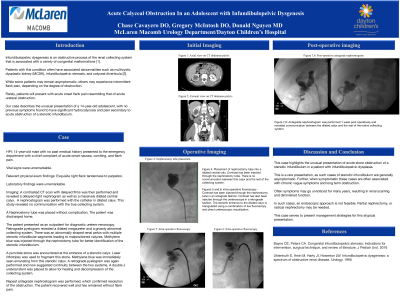Urological Surgery
Acute Calyceal Obstruction In an Adolescent with Infundibulopelvic Dysgenesis

Has Audio
Introduction/Purpose: Infundibulopelvic dysgenesis is an obstructive process of the renal collecting system that is associated with a variety of congenital malformations such as multicystic dysplastic kidney (MCDK), infundibulopelvic stenosis, and calyceal diverticula. While some patients remain asymptomatic, others may experience flank pain, depending on the degree of obstruction. Our case describes a 14-year-old adolescent, found to have severe hydrocalycosis and pain secondary to acute obstruction of a stenotic infundibulum.
Methods or Case Description: A 14-year-old male presented to the emergency department with a chief complaint of acute onset nausea, vomiting, and flank pain. Ultrasound and contrasted CT scan revealed a massively dilated central renal calyx. An antegrade nephrostogram was performed and revealed no communication between the dilated calyx and the true collecting system. A Nephrostomy tube was placed for relief.
The patient underwent cystoscopy with diagnostic uretero-renoscopy. Intraoperative pyelogram revealed a dilated megaureter and a grossly abnormal collecting system. There was an abnormal renal pelvis with multiple stenotic infundibular segments. A punctate calculus was encountered at the entrance of a stenotic calyx, and fragmented with a laser lithotripter. Methylene blue, injected through the nephrostomy tube was immediately seen emanating from this stenotic calyx. Post-procedure pyelogram suggested continuity between the two systems was re-established. A double J ureteral stent was placed.
Outcomes: Repeat nephrostogram was performed, which confirmed resolution of the obstruction. The patient recovered and has remained asymptomatic.
Conclusion: This case highlights the unusual presentation of acute stone obstruction of a stenotic infundibulum in a patient with infundibulopelvic dysplasia. This is a rare presentation, as such cases of stenotic infundibuli are generally asymptomatic. This case serves to present management strategies for this atypical presentation.
Methods or Case Description: A 14-year-old male presented to the emergency department with a chief complaint of acute onset nausea, vomiting, and flank pain. Ultrasound and contrasted CT scan revealed a massively dilated central renal calyx. An antegrade nephrostogram was performed and revealed no communication between the dilated calyx and the true collecting system. A Nephrostomy tube was placed for relief.
The patient underwent cystoscopy with diagnostic uretero-renoscopy. Intraoperative pyelogram revealed a dilated megaureter and a grossly abnormal collecting system. There was an abnormal renal pelvis with multiple stenotic infundibular segments. A punctate calculus was encountered at the entrance of a stenotic calyx, and fragmented with a laser lithotripter. Methylene blue, injected through the nephrostomy tube was immediately seen emanating from this stenotic calyx. Post-procedure pyelogram suggested continuity between the two systems was re-established. A double J ureteral stent was placed.
Outcomes: Repeat nephrostogram was performed, which confirmed resolution of the obstruction. The patient recovered and has remained asymptomatic.
Conclusion: This case highlights the unusual presentation of acute stone obstruction of a stenotic infundibulum in a patient with infundibulopelvic dysplasia. This is a rare presentation, as such cases of stenotic infundibuli are generally asymptomatic. This case serves to present management strategies for this atypical presentation.

Chase Cavayero, DO
Urology Resident
Mclaren Macomb Hospital
Mount Clemens, MI, US- GM
Gregory Mcintosh, DO
Attending Physician
Mclaren Macomb Hospital
Mt. Clemens, MI, US - DN
Donald Nguyen, MD
Dayton Children's Hospital
Dayton, OH, US
